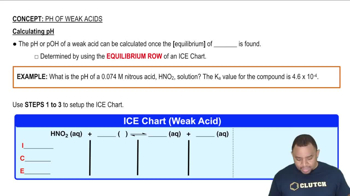Solve an equilibrium problem (using an ICE table) to calculate the pH of each solution. a. a solution that is 0.25 M in NH3 and 0.18 M in NH4Cl
Ch.18 - Aqueous Ionic Equilibrium
Chapter 18, Problem 33a
Solve an equilibrium problem (using an ICE table) to calculate the pH of each solution. a. 0.15 M HF

Verified Solution
Video duration:
3mWas this helpful?
Key Concepts
Here are the essential concepts you must grasp in order to answer the question correctly.
Equilibrium and ICE Tables
Equilibrium in chemistry refers to the state where the concentrations of reactants and products remain constant over time. An ICE table (Initial, Change, Equilibrium) is a tool used to organize the concentrations of species involved in a reaction at different stages. It helps in calculating the changes in concentration as the system reaches equilibrium, which is essential for solving equilibrium problems.
Recommended video:
Guided course

ICE Charts and Equilibrium Amount
Weak Acids and pH Calculation
Weak acids, like hydrofluoric acid (HF), do not completely dissociate in solution, leading to an equilibrium between the undissociated acid and its ions. The pH of a weak acid solution can be calculated using the acid dissociation constant (Ka) and the initial concentration of the acid. The formula pH = -log[H⁺] is used, where [H⁺] can be derived from the equilibrium concentrations established in the ICE table.
Recommended video:
Guided course

Calculating pH of Weak Acids Example
Acid Dissociation Constant (Ka)
The acid dissociation constant (Ka) quantifies the strength of a weak acid in solution, representing the equilibrium constant for its dissociation into ions. A higher Ka value indicates a stronger weak acid, while a lower Ka suggests a weaker acid. For HF, knowing its Ka value allows for the calculation of the concentration of hydrogen ions at equilibrium, which is crucial for determining the pH of the solution.
Recommended video:
Guided course

Characteristics of Ka and Kb
Related Practice
Textbook Question
Textbook Question
Solve an equilibrium problem (using an ICE table) to calculate the pH of each solution. b solution that is 0.15 M in HCHO2 and 0.25 M in NaCHO2
Textbook Question
Calculate the percent ionization of a 0.20 M benzoic acid solution in pure water and in a solution containing 0.25 M sodium benzoate. Why does the percent ionization differ significantly in the two solutions?
Textbook Question
Solve an equilibrium problem (using an ICE table) to calculate the pH of each solution. b. 0.15 M NaF
508
views
Textbook Question
Solve an equilibrium problem (using an ICE table) to calculate the pH of each solution. c. a mixture that is 0.15 M in HF and 0.15 M in NaF
1765
views
Textbook Question
A buffer contains significant amounts of acetic acid and sodium acetate. Write equations showing how this buffer neutralizes added acid and added base.
2828
views
